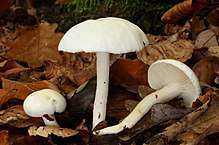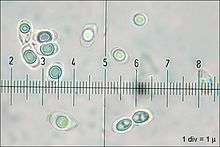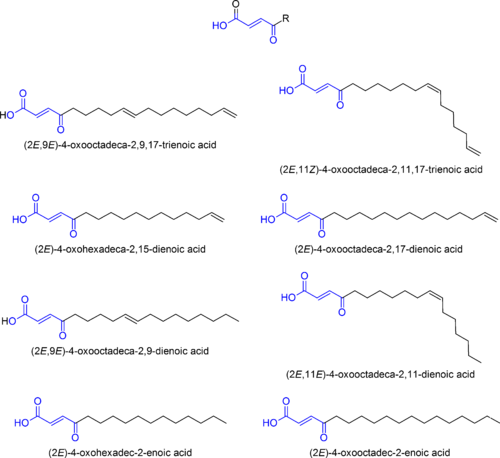Hygrophorus eburneus
Hygrophorus eburneus, commonly known as the ivory waxy cap or the cowboy's handkerchief, is a species of edible mushroom in the waxgill family of fungi. It is widespread in Europe and North America, and has also been collected in northern Africa. The fruit bodies are medium-sized, pure white, and when wet are covered in a layer of slime thick enough to make the mushroom difficult to pick up. The gills are broadly attached to the stem or running down it; as the family name suggests, they feel waxy when rubbed between the fingers. Like all Hygrophorus species, the fungus is mycorrhizal—a symbiotic association whereby the underground fungal mycelia penetrate and exchange nutrients with tree roots. They are common in a variety of forest types, where they grow on the ground in thickets or grassy areas. Hygrophorus eburneus is the type species of the genus Hygrophorus. A number of biologically active chemicals have been purified from the fruit bodies of the fungus, including fatty acids with bactericidal and fungicidal activity.
| Hygrophorus eburneus | |
|---|---|
| Scientific classification | |
| Kingdom: | |
| Division: | |
| Class: | |
| Order: | |
| Family: | |
| Genus: | |
| Species: | H. eburneus |
| Binomial name | |
| Hygrophorus eburneus (Bull.) Fr. | |
| Synonyms[1] | |
|
Agaricus eburneus Bull. | |
| Hygrophorus eburneus | |
|---|---|
float | |
| gills on hymenium | |
| cap is convex or flat | |
| hymenium is decurrent | |
| stipe is bare | |
| spore print is white | |
| ecology is mycorrhizal | |
| edibility: edible | |
Taxonomy
The species was first named as Agaricus eburneus by French botanist Jean Bulliard in 1783.[2] Elias Fries divided the large genus Agaricus into a number of "tribes" (taxonomically equivalent to modern sections) in his Systema Mycologicum I, and classified A. eburneus in the tribe Limacium.[3] When In 1836, Fries first defined the genus Hygrophorus in his Epicrisis Systematis Mycologici, H. eburneus was included.[4] The fungus has also been named Limacium eburneum by Paul Kummer in 1871,[5] when he raised the tribes of Fries to the rank of genus, and Gymnopus eburneus by Samuel Frederick Gray in 1821.[6] H. eburneus is the type species of the genus Hygrophorus, and is classified in the section Hygrophorus, subsection Hygrophorus. This includes species with non-amyloid, smooth spores, and divergent hyphae in the tissue of the hymenium. Other species in this subsection include H. eburneiformis, H. coccus, H. ponderatus, H. chrysaspis, and H. glutinosus.[7]
The mushroom is commonly known as the "ivory waxy cap",[8] the "white waxy cap",[9] or the "cowboy's handkerchief".[8] The specific epithet eburneus is a Latin adjective meaning "of ivory".[10]
Description

The cap of H. eburneus is 2 to 7 cm (0.8 to 2.8 in) broad, with a shape ranging from convex to flattened, sometimes with an umbo (a raised area in the center of the cap). In age the cap margin sometimes becomes elevated and the center of the cap depressed. The cap is pure white, and depending on the moisture in the environment, may be glutinous to sticky. The cap surface is smooth, the margin is even and in young specimens, rolled inward and covered with short fibrils. The flesh is white, thick in the center of the cap but thinning toward the margin. The odor and taste are mild. The gills are somewhat arcuate-decurrent, meaning they are shaped like a bow, curving upward and then running down the stem for a short distance. In terms of spacing, they are subdistant to distant, so that space can be seen between them. The gills are moderately broad, broadest near the stem, narrowed in front, pure white, slightly yellowish or buff with age or when dried. The stem is 4.5 to 15 cm (1.8 to 5.9 in) long, 2 to 8 mm (0.08 to 0.3 in) thick, equal in width throughout its length to somewhat tapered downward or with a greatly attenuated base, and glutinous. Its surface is silky beneath the gluten. The top of the stem is covered with short fibrils, pure white, sometimes becoming grayish or dirty with age. It is initially stuffed with cotton-like mycelia, then later becomes hollow. The caps of dried fruit bodies will typically remain white, while the stems will dry darker, especially if they are initially waterlogged.[11]
Microscopic characteristics

When they are viewed in mass, such as with a spore print, the spores appear white. Observing with a light microscope reveals additional details: spores are ellipsoid, smooth, and measure 6–8 by 3.5–5 μm. They are pale yellow in Melzer's reagent. The basidia (spore-bearing cells) are 42–52 by 608 μm, and four-spored. There are no pleurocystidia or cheilocystidia. The gill tissue is made of branching hyphae about 7–12 μm wide. The cap cuticle is made of gelatinous, narrow (3–6 μm) hyphae which are repent (bent over) but typically with some erect free ends. Clamp connections are present in the hyphae.[11]
Edibility
The mushroom is edible, although it may not be appealing to many due to its sliminess.[8] In China, a yak milk beverage is made with H. eburnus and yak milk, by lactic acid fermentation with Lactobacillus bulgaricus, Streptococcus thermophilus and Lactobacillus acidophilus as mixed starter.[12]
Similar species
A lookalike species of Hygrophorus eburneus is H. piceae, which differs by having a less slimy cap, dry to slightly viscid stem, and frequent association with spruce. H. gliocyclus is just as slimy, but has a cream-colored cap, thicker stalk, and grows with pine.[13] The "snow white waxy cap" (H. borealis) is also similar in appearance, but has a smaller cap diameter of up to 4.5 cm (1.8 in)—and is not slimy.[14] Hygrophorus cossus, which typically grows with Quercus species, differs in its pale pinkish-buff cap and gills, and has a distinct sour odor; also, H. cossus does not have a potassium hydroxide reaction on the stem as does H. eburneus.[15] The "white slime mushroom" (Limacella illinita) has non-waxy gills that are free from attachment to the stalk.[16]
Habitat and distribution
The fruit bodies of H. eburneus grow on the soil, mostly in coniferous woods, thickets and grassy areas.[11] The fungus prefers soil that is moist, mesic, loamy and calcareous.[17]
The fungus is widely distributed in North America.[11] It is also found in Europe (Poland[18] and Portugal[19]), Israel[20] and North Africa.[21]
Bioactive compounds

Several fatty acids with bactericidal and fungicidal activity have been isolated and identified from the fruit bodies of H. eburneus. The bioactive fatty acids are built upon a chemical structure called γ-oxocrotonate. The following gamma-oxocrotonate derivatives have been identified from the mushroom: (2E,9E)-4-oxooctadeca-2,9,17-trienoic acid, (2E,11Z)-4-oxooctadeca-2,11,17-trienoic acid, (E)-4-oxohexadeca-2,15-dienoic acid, (E)-4-oxooctadeca-2,17-dienoic acid, (2E,9E)-4-oxooctadeca-2,9-dienoic acid, (2E,11Z)-4-oxooctadeca-2,11-dienoic acid, (E)-4-oxohexadec-2-enoic acid, and (E)-4-oxooctadec-2-enoic acid.[22] The compound (E)-4-oxohexadec-2-enoic acid has been investigated for potential use as a fungicide against the oomycete species Phytophthora infestans, a causal agent of potato and tomato late blight disease.[23]
Additional secondary metabolites discovered in H. eburneus include the ceramide compound named hygrophamide ((2S,3R,4R,2'R)-2-(2'-hydroxy-9'Z-ene-tetracosanoylamino)-octadecane-1,3,4-triol),[24] and the β-carboline alkaloids known as harmane and norharmane. The report of discovery of the latter two compounds in 2008 represents their first known occurrence in fungal fruit bodies.[25]
See also
References
- "Hygrophorus eburneus (Bull.) Fr". Index Fungorum. CAB International. Retrieved 2010-08-25.
- Bulliard JBF. (1783). Herbier de la France (in French). 3. pp. 97–144.
- Fries EM. (1821). Systema Mycologicum (in Latin). 1. ex officina Berlingiana. p. 16. Retrieved 2010-06-30.
- Fries EM. (1836). Anteckningar öfver de i Sverige växande ätliga svampar (in Swedish). p. 45.
- Kummer P. (1871). Der Führer in die Pilzkunde (1 ed.). Zerbst. p. 119.
- Gray SF. (1821). A Natural Arrangement of British Plants. p. 610.
- Hesler and Smith, 1963, p. 248.
- Arora D. (1986). Mushrooms Demystified: a Comprehensive Guide to the Fleshy Fungi. Berkeley, California: Ten Speed Press. pp. 119–20. ISBN 978-0-89815-169-5. Retrieved 2010-08-25.
- Bessette A, Bessette AR, Fischer DW (1997). Mushrooms of Northeastern North America. Syracuse University Press. p. 139. ISBN 978-0-8156-0388-7. Retrieved 2010-08-25.
- Headrick D, Gordh G (2001). A Dictionary of Entomology. Wallingford, Oxon, UK: CABI Pub. p. 301. ISBN 978-0-85199-655-4.
- Smith, 1947, pp. 253–55.
- Fang JP, Zhong ZC (2009). "Study on Hygrophorus eburnus - yak milk beverage". China Dairy Industry (in Chinese). 37 (6): 62–64. ISSN 1001-2230.
- Arora D. (1991). All that the Rain Promises and More: a Hip Pocket Guide to Western Mushrooms. Berkeley, California: Ten Speed Press. p. 47. ISBN 978-0-89815-388-0. Retrieved 2010-08-25.
- Roody, 1997, p. 119. Retrieved 2010-06-30.
- Miller HR, Miller OK (2006). North American Mushrooms: a Field Guide to Edible and Inedible Fungi. Guilford, Conn: Falcon Guide. p. 69. ISBN 978-0-7627-3109-1. Retrieved 2010-08-25.
- Roody, 1997, p. 250. Retrieved 2010-08-25.
- Bas C, Kuyper TW, Noordeloos ME, Vellinga EC (1990). Flora Agaricina Neerlandica. 3. Boca Raton, Florida: CRC Press. pp. 118–19. ISBN 978-90-6191-971-1. Retrieved 2010-08-25.
- Lisiewska M. (1963). "Higher fungi of forest associations of the beech forest near Szczecin". Monographie Botanicae. 15: 77–151. doi:10.5586/mb.1963.003.
- Louro R, Calado M, Pinto B, Santos-Silva C (2009). "Epigeous macrofungi of the Parque de Natureza de Noudar in Alentejo (Portugal)". Mycotaxon. 107: 49–52. doi:10.5248/107.49. hdl:10174/1792.
- Binyamin N, Avizohar Z (1973). "Species of Hygrophorus in Israel". Israel Journal of Botany. 22 (4): 258–62.
- Maire R. (1928). "New fungi from N. Africa". Bulletin Trimestriel de la Société Mycologique de France. 44 (1): 37–56.
- Teichert A, Lubken T, Schmidt J, Porzel A, Arnold N, Wessjohann L (2005). "Unusual bioactive 4-oxo-2-alkenoic fatty acids from Hygrophorus eburneus". Zeitschrift für Naturforschung B. 60 (1): 25–32. doi:10.1515/znb-2005-0105.
- Eschen-Lippold L, Draeger T, Teichert A, Wessjohann L, Westermann B, Rosahl S, Arnold N (2009). "Antioomycete activity of gamma-Oxocrotonate fatty acids against P. infestans". Journal of Agricultural and Food Chemistry. 57 (20): 9607–12. doi:10.1021/jf902067k. PMID 19778058.
- Qu Y, Zhang HB, Liu JK (2004). "Isolation and structure of a new ceramide from the Basidiomycete Hygrophorus eburneus". Zeitschrift für Naturforschung B. 59 (2): 241–44. doi:10.1515/znb-2004-0218.
- Teichert A, Lübken T, Schmidt J, Kuhnt C, Huth M, Porzel A, Wessjohann L, Arnold N (2008). "Determination of β-carboline alkaloids in fruiting bodies of Hygrophorus spp. by liquid chromatography/electrospray ionisation tandem mass spectrometry". Phytochemical Analysis. 19 (4): 335–41. doi:10.1002/pca.1057. PMID 18401852.
Literature cited
- Roody WC. (2003). Mushrooms of West Virginia and the Central Appalachians. Lexington, Kentucky: University Press of Kentucky. ISBN 978-0-8131-9039-6.
- Smith AH. (1947). North American species of Mycena. Ann Arbor, Michigan: University of Michigan Press.
External links
| Wikimedia Commons has media related to Hygrophorus eburneus. |